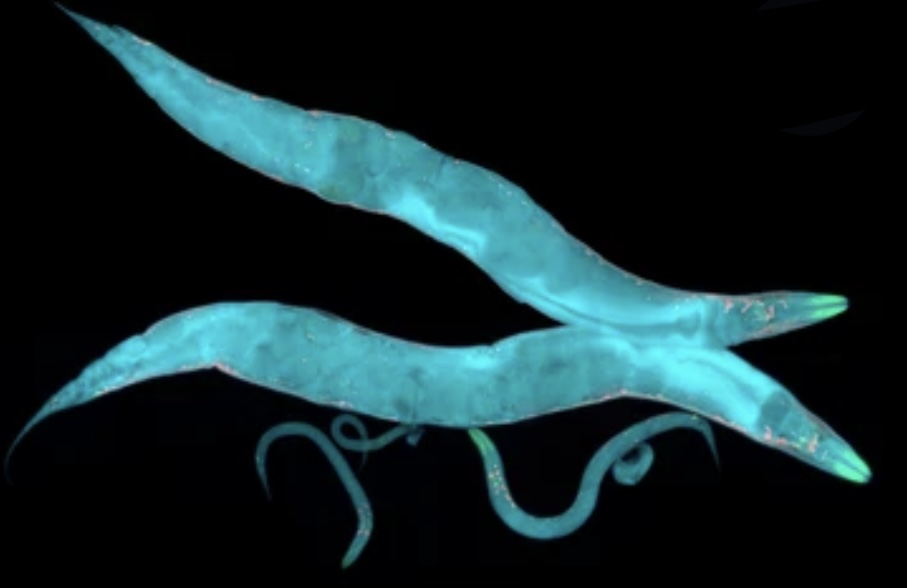INTRODUCTION
- Development of C. elegans begins when a fertilized egg undergoes a series of cell divisions to form a multicellular embryo.
- C.elegans (Caenorhabditis elegans) is a roundworm that has been extensively studied as a model organism in developmental biology. It has a relatively simple anatomy and a fully sequenced genome, which make it an ideal model for studying fundamental biological processes.
C. ELEGANS DEVELOPMENT
- C. elegans development begins when a fertilized egg undergoes a series of cell divisions to form a multicellular embryo. The first division is asymmetric, resulting in two cells with different fates: the anterior cell will give rise to the head and tail regions, while the posterior cell will give rise to the body.
- The cells of the developing embryo are arranged in a specific pattern, with cells in the outermost layer (the ectoderm) differentiating into various tissues such as the nervous system, skin, and muscles. The cells in the inner layer (the endoderm) give rise to the digestive system and other internal organs.
- During development, C. elegans undergoes several distinct stages. The first stage is the embryonic stage, which lasts for about 14 hours and ends with hatching of the larvae. The larvae then go through four molts, or stages of growth, before reaching adulthood. Each molt involves shedding the old cuticle and secreting a new one.
- C. elegans development is highly regulated by genes and signaling pathways. Mutations in various genes can cause developmental abnormalities, such as defects in body patterning, organ development, or molting. Studying these genes and pathways in C. elegans can provide insight into similar processes in other organisms, including humans.
STAGES OF DEVELOPMENT

The development of C. elegans can be divided into several distinct stages:
- Fertilization: C. elegans is a hermaphrodite that can self-fertilize or mate with a male worm. During mating, the male deposits sperm into the hermaphrodite’s reproductive tract, where it fertilizes the egg. The fertilized egg is called a zygote, which has a single nucleus containing genetic material from both parents.
- Embryonic development: The zygote undergoes a series of rapid cell divisions to form a multicellular embryo. During this stage, the embryo undergoes morphological changes, such as gastrulation, which is the formation of a cavity within the embryo. The cavity becomes the gut of the developing worm. The embryo then forms distinct germ layers, which give rise to the various tissues and organs of the adult worm.
- Larval stages: After hatching from the egg, C. elegans goes through four larval stages, also known as L1 to L4. During these stages, the worm grows in size and undergoes molting, where it sheds its old cuticle and secretes a new one. The larvae feed on bacteria and gradually develop the features of the adult worm, such as the reproductive system, nervous system, and digestive system.
- Adult stage: After the fourth molt, the worm reaches the adult stage, where it is sexually mature and can reproduce. The adult C. elegans has a fully developed nervous system, reproductive system, and other internal organs. Adult hermaphrodites can self-fertilize, or they can mate with a male to produce offspring.
Throughout C. elegans development, several genes and signaling pathways regulate various processes such as cell differentiation, organ development, and morphogenesis. Studies on C. elegans have led to many important discoveries, including the role of apoptosis (programmed cell death) in development, the genetic control of cell lineage, and the mechanisms underlying axon guidance. C. elegans has also been used to study the aging process and neurodegenerative diseases.
CONCLUSION
In conclusion, the development of C. elegans is a well-studied process that has provided important insights into the basic biology of multicellular organisms. From fertilization to the adult stage, C. elegans undergoes a series of distinct stages that are regulated by complex genetic and signaling pathways. Its relatively simple anatomy and fully sequenced genome make it an ideal model organism for studying fundamental biological processes. Research on C. elegans development has led to many important discoveries and continues to be a valuable tool for understanding the basic biology of life.
Discover more from ZOOLOGYTALKS
Subscribe to get the latest posts sent to your email.


